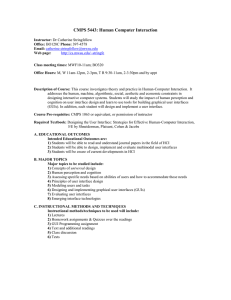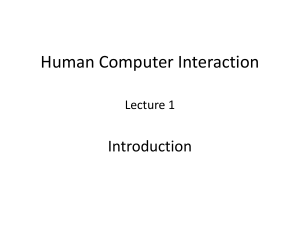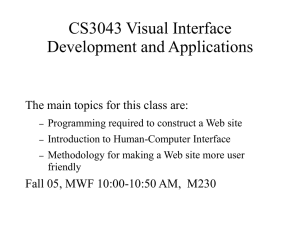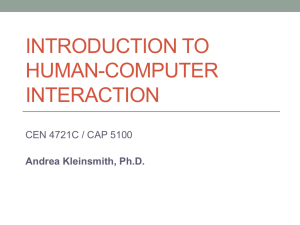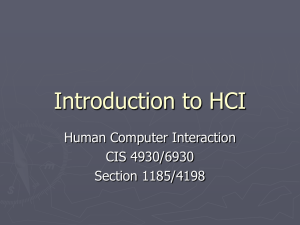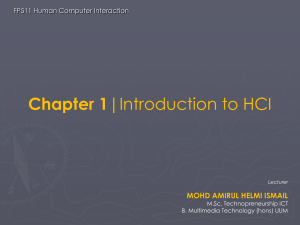Xiuyuan Wu Tutor proposed: Chengzhi Peng, Tsung
advertisement
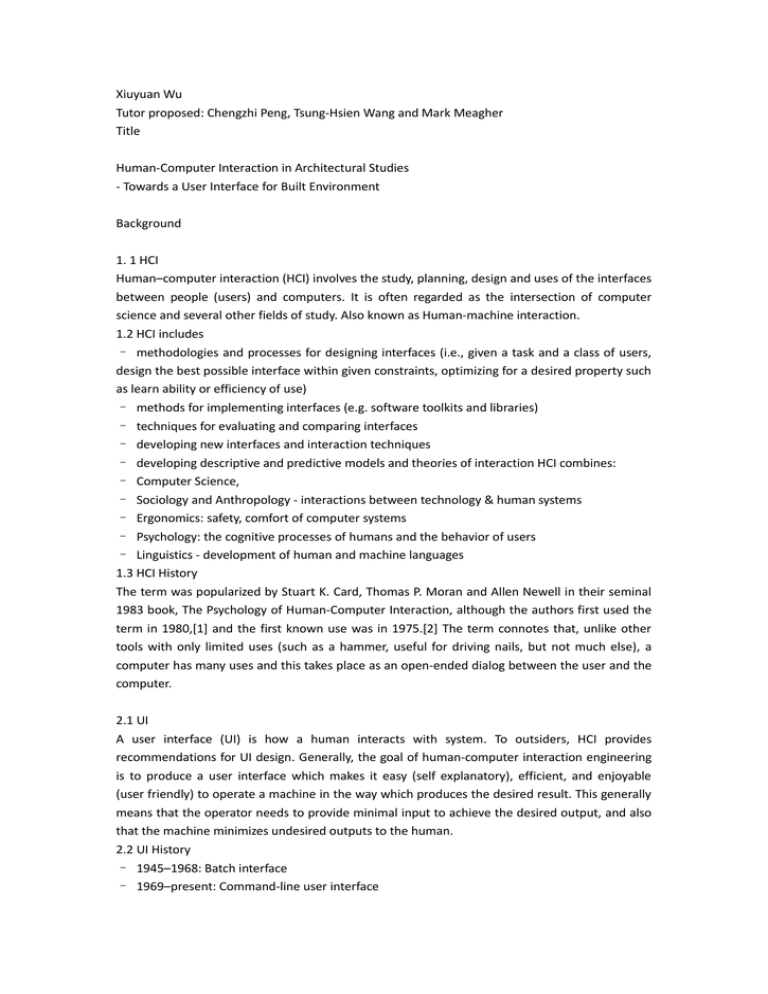
Xiuyuan Wu Tutor proposed: Chengzhi Peng, Tsung-Hsien Wang and Mark Meagher Title Human-Computer Interaction in Architectural Studies - Towards a User Interface for Built Environment Background 1. 1 HCI Human–computer interaction (HCI) involves the study, planning, design and uses of the interfaces between people (users) and computers. It is often regarded as the intersection of computer science and several other fields of study. Also known as Human-machine interaction. 1.2 HCI includes – methodologies and processes for designing interfaces (i.e., given a task and a class of users, design the best possible interface within given constraints, optimizing for a desired property such as learn ability or efficiency of use) – methods for implementing interfaces (e.g. software toolkits and libraries) – techniques for evaluating and comparing interfaces – developing new interfaces and interaction techniques – developing descriptive and predictive models and theories of interaction HCI combines: – Computer Science, – Sociology and Anthropology - interactions between technology & human systems – Ergonomics: safety, comfort of computer systems – Psychology: the cognitive processes of humans and the behavior of users – Linguistics - development of human and machine languages 1.3 HCI History The term was popularized by Stuart K. Card, Thomas P. Moran and Allen Newell in their seminal 1983 book, The Psychology of Human-Computer Interaction, although the authors first used the term in 1980,[1] and the first known use was in 1975.[2] The term connotes that, unlike other tools with only limited uses (such as a hammer, useful for driving nails, but not much else), a computer has many uses and this takes place as an open-ended dialog between the user and the computer. 2.1 UI A user interface (UI) is how a human interacts with system. To outsiders, HCI provides recommendations for UI design. Generally, the goal of human-computer interaction engineering is to produce a user interface which makes it easy (self explanatory), efficient, and enjoyable (user friendly) to operate a machine in the way which produces the desired result. This generally means that the operator needs to provide minimal input to achieve the desired output, and also that the machine minimizes undesired outputs to the human. 2.2 UI History – 1945–1968: Batch interface – 1969–present: Command-line user interface – 1985: S.A.A. User Interface or Text-Based User Interface – 1968–present: Graphical User Interface 2.3 User interface design (UID) or user interface engineering – – – – – – – Functionality requirements gathering User and task analysis Information architecture Prototyping Usability inspection Usability testing Graphical user 3. Possible implications for built environment 1.System Building automation/ Intelligent Building Building automation is an example of a distributed control system - the computer networking of electronic devices designed to monitor and control the mechanical, security, fire and flood safety, lighting (especially emergency lighting), HVAC and humidity control and ventilation systems in a building.[1] figure 1 2. Technologies Virtual Reality/ Augmented Reality/ Mixed Reality/ Holographic Projection For example, AR can aid in visualizing building projects. Computer-generated images of a structure can be superimposed into a real life local view of a property before the physical building is constructed there. AR can also be employed within an architect's work space, rendering into their view animated 3D visualizations of their 2D drawings. Architecture sight-seeing can be enhanced with AR applications allowing users viewing a building's exterior to virtually see through its walls, viewing its interior objects and layout. Problem Statement 1.What is Human–computer interaction? The history it developed. 2.What is user interface? What is it relationship with HCI? 3.How to design user interface? 4.How UID change our life? like flat design. 5.How to apply UID into architecture field? It's connection with interactive built environment. 6.How to define interface in architecture word? 8.Is there any similar design ideas are close to HCI? 9.What technologies could be useful to construct a user design for built environment. 10.A initial proposal for a prototype between UI and IBE. 11.What problems could be found after testing this proposal? figure 2 Methodology 1. Literature Research Selection and discussion of theoretical material and descriptive material, in context, and detailed comparison of theories in terms of their applicability. For example, translating the HCI theories into the architecture context. 2. Model Research International Federation for Information Processing user interface reference model. The model proposes four dimensions to structure the user interface: The input/output dimension (the look) The dialogue dimension (the feel) The technical or functional dimension (the access to tools and services) The organizational dimension (the communication and co-operation support) 3. Iterative design (prototyping, testing, analyzing, and refining a product or process) Iterative design is commonly used in the development of human computer interfaces. This allows designers to identify any usability issues that may arise in the user interface before it is put into wide use. Even the best usability experts cannot design perfect user interfaces in a single attempt, so a usability engineering lifecycle should be built around the concept of iteration.[1] The typical steps of iterative design in user interfaces are as follows: – – – – – Complete an initial interface design Present the design to several test users Note any problems had by the test user Refine interface to account for/fix the problems Repeat steps 2-4 until user interface problems are resolved Significance and Outcomes The goal is to bring the power of computers and communications systems to people in architecture forms that are both accessible and useful in our working, learning, communicating, and recreational lives. Toward this end, technologies such as the graphical user interface, virtual environments, speech recognition, gesture and handwriting recognition, multimedia presentation, and cognitive models of human learning and understanding are developed and applied as part of research agendas. A kind of site-application of User Interface for Built Environment will be proposed to test the ideas, through system design or prototype design. Bibliography and Sources Julie A. Jacko (Ed.). (2012). Human-Computer Interaction Handbook (3rd Edition) Stuart K. Card, Thomas P. Moran, Allen Newell (1983): The Psychology of Human–Computer Interaction. Erlbaum, Hillsdale 1983 John M. Carroll: Human Computer Interaction: History and Status. Encyclopedia Entry at Interaction-Design.org "SUPPLE: Automatically Generating Personalized User Interfaces". Intelligent Interactive Systems Group (website). Harvard University. 2007-05-07 Raskin, Jef (2000). The human interface : new directions for designing interactive systems (1. printing. ed.). Reading, Mass. [u.a.]: Addison Wesley

